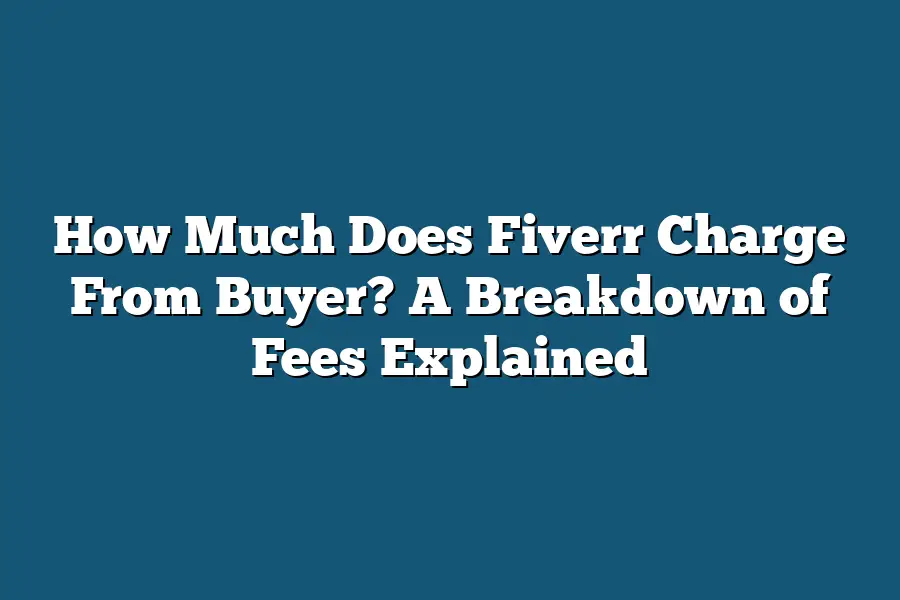Fiverr charges a small fee to buyers, which is 5% of the order value. This fee is deducted from the payment made by the buyer to the seller. For example, if a buyer pays $100 for an order, Fiverr would deduct $5 (5%) and pay the remaining $95 to the seller. The 5% fee is waived for orders worth $20 or less.
As someone who’s earned a living from Fiverr, I’ve had my fair share of surprises when it comes to the fees.
At first, I was oblivious to the fact that there were different types of fees involved – not just for sellers, but also for buyers!
It wasn’t until I delved deep into the world of freelance work that I realized how much Fiverr charges from buyers.
And let me tell you, it’s more than just a small percentage.
In this post, I’ll break down the various fees that Fiverr takes from buyers, including the service fee, payment processing fees, and order completion rate.
You’ll also learn about other costs to consider, such as currency conversion fees and additional taxes or duties.
But don’t worry, I won’t leave you feeling like you’ve been caught in a trap – I’ll also share some valuable tips on how to minimize these fees and get the most out of your Fiverr experience.
Table of Contents
What Does Fiverr Charge Buyers?
As a buyer on Fiverr, you’re probably wondering what you’ll be paying for those gigs.
Well, I’ve got the lowdown on Fiverr’s fees to help you plan your project budget.
Service Fee: 5% Commission on Each Order
Fiverr takes a 5% commission on every order, which might not seem like a lot, but it adds up – especially for larger projects.
So, what does this look like in practice?
Let me break it down:
- Order total: $100
- Service fee: $5 (5% of the order total)
- Your cost: $95
That’s a pretty straightforward calculation, right?
But here’s the thing: this 5% commission is only charged on the order total, not the individual gigs you purchase.
So, if you’re buying multiple services from different sellers, the service fee will be calculated based on the grand total of your order.
Payment Processing Fees: Credit Card Processing Fees Explained
When you use a credit card to pay for Fiverr orders, there’s an additional payment processing fee tacked on.
This fee is actually charged by the payment processor (in this case, Stripe), not Fiverr itself.
The good news?
This fee is typically pretty small – around 2.9% + $0.30 per transaction.
To put that into perspective:
- Order total: $100
- Service fee: $5 (as calculated above)
- Payment processing fee: $3.70 (2.9% of the order total + $0.30)
- Your cost: $98.70
Now, you might be wondering how this compares to other payment platforms like PayPal.
Well, PayPal’s fees can range from 2.9% + $0.30 per transaction to 3.4% + fixed fees depending on the type of account and the amount transferred.
Order Completion Rate: The Impact on Buyer Reputation
So, what happens if your order isn’t completed as agreed upon?
That’s when Fiverr’s Order Completion Rate (OCR) comes into play.
Your OCR is calculated based on the percentage of orders you’ve successfully completed – and it can have a big impact on your buyer reputation.
- Good OCR: 90% or higher
- Fair OCR: 80-89%
- Cautionary OCR: 70-79%
- Poor OCR: Below 70%
If your OCR drops below 70%, you might start to see some negative consequences – like being flagged as a low-reputation buyer.
Ouch!
There you have it, folks!
A breakdown of Fiverr’s fees and how they can affect your project budget.
Whether you’re a seasoned buyer or just starting out, understanding these fees is crucial for planning your project – and avoiding any nasty surprises down the line.
Other Fees to Consider
When you’re all set to buy a gig on Fiverr, you might think you’ve got everything figured out – but wait!
There are some sneaky fees lurking beneath the surface.
In this section, we’ll dive into two more charges you should know about: Fiverr’s Currency Conversion Fee and those pesky Additional Taxes or Duties.
Fiverr’s Currency Conversion Fee (if applicable): A Fee That’s All About Exchange Rates
So, you’re based in London, but the seller is from Rio de Janeiro.
No worries!
Fiverr’s got your back – or should I say, they’ve got your money?
When you pay for a gig using a currency other than the one listed on the seller’s page (like USD), Fiverr slaps on a tiny 2% Currency Conversion Fee.
That’s right, folks – it’s all about exchange rates.
Here’s how it works: let’s say you’re buying a $100 gig from a Brazilian seller who only accepts R$500.
Fiverr will convert that R$500 to USD using the current exchange rate (around 1 USD = 4-5 R$.
Then, they’ll add their 2% conversion fee – which comes out to around $2-$3 in this case.
So, your total payment would be approximately $102-$103.
Now, I know what you’re thinking: “That’s a small price to pay for hassle-free international transactions!” And I agree – but it’s still good to know about this extra charge when planning your budget.
Additional Taxes or Duties: A Global Tax Tussle
Here’s where things get really interesting (and sometimes, really pricey).
As the buyer, you’re responsible for paying any additional taxes or duties on your gig purchase.
These fees vary greatly depending on the country you’re in – and sometimes, even the city or state.
Let me give you a few examples of countries with notoriously high tax rates:
- Canada: You might be familiar with Canada’s notorious 15% Harmonized Sales Tax (HST). That’s on top of any provincial taxes that apply.
- Australia: Aussies are known for their love of coffee – and they also love paying taxes! Expect around 10-15% Goods and Services Tax (GST) in most cases.
- Sweden: Ah, Sweden – land of the midnight sun and high taxes. You might face up to 25% Value-Added Tax (VAT), depending on your location.
These additional fees are usually calculated based on the total cost of the gig, including any applicable VAT or GST.
So, if you’re buying a $50 gig in Australia, for instance, you could end up paying around $57-$60 after taxes.
Now, before you start panicking about those pesky tax rates, just remember: Fiverr will always provide you with an estimated total cost upfront – including any applicable fees.
So, plan ahead, and you’ll be all set to enjoy your gig without any nasty surprises!
That’s it for our peek into the world of Fiverr fees!
Next time, we’ll dive into the nitty-gritty details of how Fiverr calculates its fees and what you can do to minimize them.
Stay tuned!
Tips for Minimizing Fees on Fiverr
As a savvy buyer on Fiverr, you’re always looking for ways to get the most bang for your buck.
But did you know that those pesky service fees can eat away at your budget?
In this section, I’ll share some valuable tips and best practices to help you minimize those fees and get the most out of your Fiverr experience.
Strategies for Optimizing Your Projects
Let’s face it – Fiverr’s service fees are a reality.
But that doesn’t mean you can’t take steps to reduce them!
Here are a few strategies to help you optimize your projects and minimize those pesky fees:
- Break down large projects into smaller ones: By breaking down a single project into multiple smaller tasks, you’ll avoid being hit with the 5% service fee on the entire project. This is especially useful for longer-term projects that require ongoing work.
- Use Fiverr’s payment protection: If you’re working on a larger project or have concerns about the freelancer’s performance, use Fiverr’s payment protection to secure your funds and avoid any potential disputes.
- Negotiate with freelancers: Sometimes, negotiations can go a long way in reducing fees. Don’t be afraid to ask freelancers if they’re willing to adjust their rates or offer discounts for longer-term projects.
The Importance of Accurate Estimates
Accurate estimates are crucial when it comes to avoiding additional fees on Fiverr.
Here’s why:
- Underestimate, and you’ll pay the price: If your estimate is too low, you might find yourself facing additional fees or even project disputes.
- Overestimate, and you’ll waste money: On the other hand, if your estimate is too high, you’ll be wasting precious budget on unnecessary work.
To avoid these pitfalls, make sure to:
- Take the time to scope out the project: Don’t rush into a project without taking the time to understand what’s required.
- Break down complex projects into smaller tasks: This will help you create more accurate estimates and avoid those pesky additional fees.
Best Practices for Handling Disputes
Disputes can be a major headache when working with freelancers on Fiverr.
Here are some best practices to help you navigate these situations:
- Communicate early and often: If issues arise, communicate with the freelancer promptly to resolve them.
- Use Fiverr’s support team: Don’t hesitate to reach out to Fiverr’s support team if a dispute arises. They’re there to help you resolve the issue!
- Keep records of communication: Keep a record of all communication with the freelancer, including emails, messages, and phone calls. This will help you track progress and avoid misunderstandings.
By following these tips, you’ll be well on your way to minimizing fees on Fiverr and enjoying a smooth project completion.
Happy buying!
Final Thoughts
As I wrap up this breakdown of Fiverr’s fees, one thing is clear: understanding how much you’ll be charged as a buyer can make all the difference in your experience on the platform.
By grasping the nuances of Fiverr’s service fee, payment processing fees, and order completion rate, you’ll be better equipped to plan your projects and minimize costs.
And let’s not forget about those pesky currency conversion fees and additional taxes – now you know what to expect and how to prepare.
With these insights, you’re ready to dive into the world of Fiverr with confidence.
So go ahead, start a project, and watch your ideas come to life without breaking the bank.


